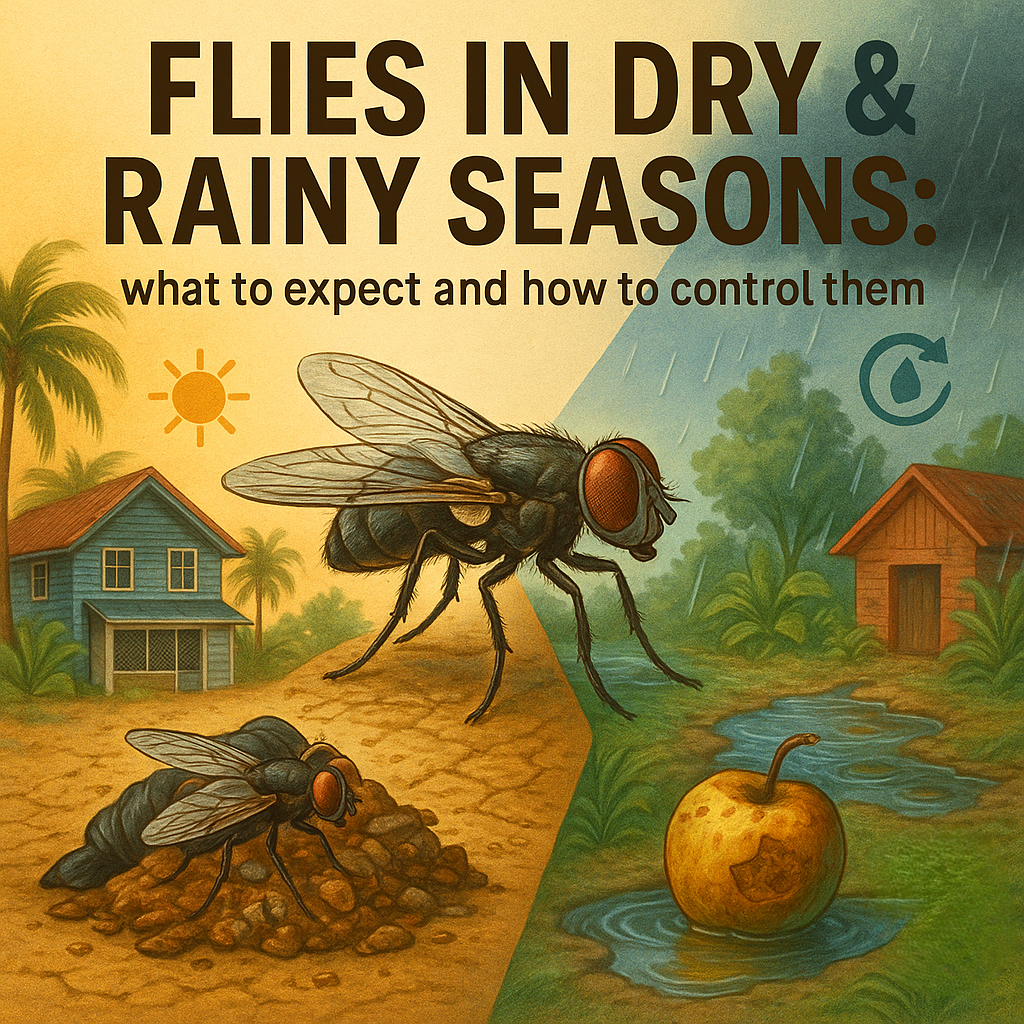
Climate and Fly Behavior
How Dry and Rainy Seasons Affect Their Activity, Reproduction, and Proliferation
When we think of flies, we often picture them as a constant nuisance throughout the year. However, their behavior is strongly influenced by climatic factors, especially in tropical islands like Aruba, where two distinct seasons prevail: the dry and the rainy season. These environmental conditions not only determine their activity level but also their reproduction, lifespan, and potential to become pests in both urban and rural environments.
In this article, we explore how climate impacts flies in Aruba, why they proliferate more during certain times of the year, and how Eco Fauna Control offers effective and sustainable strategies to manage their presence while respecting the local ecological balance.
Dry Season: Less Water, More Flies
Why does fly activity increase during drought?
In Aruba, the dry season typically runs from January to June, with low rainfall and high solar radiation. During this period, organic matter tends to ferment more quickly due to heat, producing strong odors that attract flies, especially saprophagous species (Musca domestica, Lucilia spp., etc.).
Additionally, with less moisture available in the environment, many adult flies are forced to concentrate around remaining water sources such as:
-
Poorly sealed garbage bins
-
Residual puddles near kitchens or shared spaces
-
Air conditioner drip trays or neglected drains
Adaptations during dry weather
Despite fewer natural breeding sites (like puddles or moist manure), flies compensate with high mobility and strong olfactory senses, quickly locating new food sources and places to lay eggs.
In rural areas, it’s common to see them around compost piles, animal pens, and decomposing crop residues, which ferment rapidly in the sun—ideal conditions for reproduction.
Rainy Season: Humidity as a Biological Catalyst
Increase in breeding sites and ideal conditions
Between July and December, intermittent rainfall transforms the landscape. Ambient humidity rises, and multiple water accumulation points emerge, facilitating mass reproduction of flies, especially those that require moist substrates to complete their life cycle.
During this season, you may observe:
-
Increased larvae in moist organic waste
-
Greater presence of black flies and other species of veterinary importance
-
Accelerated proliferation of Drosophila melanogaster (fruit fly), common in markets and kitchens
Accelerated multiplication
The fly life cycle, which under normal conditions can last between 15 and 30 days, accelerates significantly with warm temperatures and high humidity. A fly can complete its cycle from egg to adult in just 7 days during the rainy season, producing multiple generations in a few weeks.
In urban settings, poorly drained patios, sewers, clogged gutters, and neglected gardens become perfect breeding grounds. Without intervention, the population can surge quickly, affecting both homes and businesses.
Climatic Influence on Specific Fly Species
Different fly species react in distinct ways depending on the climate. Below is a summary of the most common ones found in Aruba:
| Species | Behavior in Dry Season | Behavior in Rainy Season |
|---|---|---|
| Musca domestica | Active around fermenting waste, lower reproduction | Increased reproduction in moist organic material |
| Lucilia spp. (green bottle) | Found in rural areas, seeks carcasses or open wounds | Rapid reproduction in moist decaying matter |
| Drosophila melanogaster | Moderate presence on fermented fruit | Population explosion in kitchens and markets |
| Stomoxys calcitrans | Searches for hosts in shaded areas | More bites and irritation in moist livestock environments |
Differences Between Urban and Rural Environments
In Urban Areas:
-
Poorly managed household waste and stagnant water are the main attractants.
-
Flies find shelter in shaded areas, outdoor kitchens, and blocked drains.
-
During rains, breeding sites multiply in poorly designed yards or roofs with water buildup.
In Rural Areas:
-
Pens, barns, and feed storage provide abundant organic matter.
-
Moist manure and decomposing vegetation act as natural incubators.
-
Poorly managed agricultural activity can intensify reproductive cycles.
Why Understanding This Behavior Is Crucial
Knowing the relationship between climate and fly behavior in Aruba allows us to:
-
Predict periods of higher sanitary risk
-
Apply preventive measures before infestations occur
-
Select the most appropriate control method for each season
This anticipatory and adaptive approach is a core part of Eco Fauna Control’s philosophy.
Smart Solutions
At Eco Fauna Control, we understand that pest management must adapt to local context. That’s why our fly control plans are designed with Aruba’s climate conditions in mind:
🔬 Seasonal diagnostic evaluations: We assess current and forecasted conditions to design tailored strategies.
🧪 Integrated Pest Management (IPM): We combine biological, physical, and chemical control based on the time of year.
🌿 Environmental sustainability: We minimize the use of chemicals and protect non-target species.
📊 Ongoing monitoring and follow-up: We assess the effectiveness of treatments and adapt to climate shifts.
Aruba’s climate, with its alternating dry and rainy seasons, has a direct impact on the behavior and proliferation of flies. While the heat of the dry season stimulates their activity, the humidity of the rainy season accelerates their reproduction. This dynamic requires a smart, preventive, and climate-adapted management approach.
At Eco Fauna Control, we don’t just eliminate pests — we understand them. And that allows us to offer more effective, sustainable, and safe solutions for your home, business, or farm.
If you want to keep your environment fly-free all year round, contact us today. We’re ready to help!
